Jay Epae is the forgotten voice of New Zealand music. He was the first New Zealander to have an international No.1 record in Sweden and Finland, in 1961, and was signed to the major US labels Mercury and Capitol, where he recorded with some of the biggest names in the music industry.
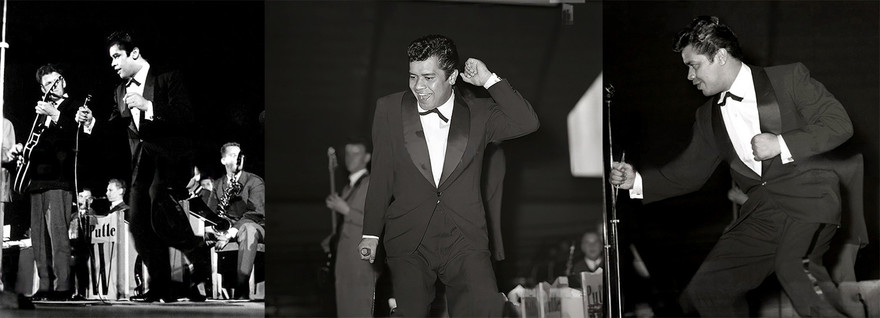
Jay Epae on stage in Sweden, early 1960s. - Epae Family Collection
Nicholas (Jay) Epae was born in 1934, the third of eight children, Dawson, Roy, Jay, Tuia, Darcy, Huia, Wes and Hector. The Epae whānau came from the south Taranaki town of Manaia. Jay’s father Tuni served in the Pioneer Māori Battalion during the First World War and was a respected member of the local community. A Hawera newspaper from 1929 described him as “a tenor singer with a strong and varied range and a remarkably good power of expression,” Jay’s mother Manakore was also an excellent singer and was a member of several local cultural groups.
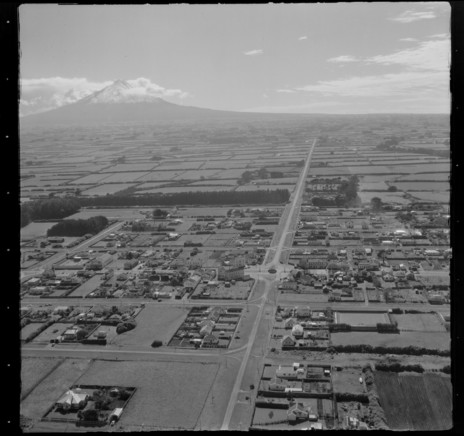
Manaia, South Taranaki, in 1958. - Whites Aviation photo, Alexander Turnbull Library, Wellington; WA-47146-F
After the birth of Hector in 1942, the Epae children’s mother Manakore suddenly passed away. Jay’s sister Tui recalled: “Dad was a farm hand and obviously couldn’t cope with eight kids, so except for Dawson who was of working age, we were all billeted out to the wider family. I was sent to Uncle Harry’s farm while Jay and Roy went to Johnny Robinson’s farm, which was dad’s sister’s family. Shortly afterwards Dad got a job in Wellington. I wanted to go with him. I didn’t want to stay in the Taranaki so I walked the 14 km to the Hawera railway station, carrying my shoes, so that I wouldn’t wear them out.
“After saying goodbye, I stowed away in the luggage compartment of Dad’s train. I knew that we had arrived in Wellington because of the commotion outside, but I was collared almost straight away by the inspector. I told him that I was with my dad but because I didn’t have a ticket I was marched to the office where they announced over the loudspeaker for Mr Epae to report to the office for a surprise. He was surprised alright, but he let me stay with him, albeit at the YWCA while he stayed at the YMCA.
“Jay went to Normanby public school. He left school when he was 10 as he always got the strap. He would grab the strap from the teachers and whack them back. He was naughty. Father Wall would visit houses in the area, he tutored Jay and taught him how to box.”
Jay excelled as a boxer, but his promising career took a terminal blow when he broke his wrist during a fight. He took great pride in telling everybody that although he had broken his wrist he still managed to finish the fight as the winner.
as a 21-year-old in 1954, Jay made his way to Sydney, where he found work in a Sydney nightclub
After leaving school Jay and Roy worked as farm hands on their uncle’s farm. Jay would dream of a life in show business and in 1954 as a 21-year-old made his way to Sydney, where he found work in a Sydney nightclub. Wes Epae recalls, “One day he was here and the next day he was gone, Sydney bound, seeking fame and fortune, I have to give it to him though, he backed himself, there was a whole pile of us who headed for Sydney about five years later, all in Māori showbands, Jay did it on his own. Māori showbands hadn’t been invented when Jay left.”
Jay’s brothers Wes and Hector also had long careers in the music industry. Wes in the Māori Hi Five, and Hector as a member of The Māori Volcanics.
Without knowing it, Jay’s musical future was falling into place, half a world away in Italy. Leona Laviscount was a New York-born jazz dancer and singer who had been touring Europe for four years as a dancer in Claude Marchant’s Dancers. In the 17 June 1954 edition of the weekly Black news-magazine Jet she revealed that she hoped to marry Italian oil and rubber magnate Ben Enrico Goldsmith, to whom she had become very close after meeting him during a performance at the Sistina Theatre in Rome. The marriage obviously never took place and instead Leona found herself a year later touring Australia, as a member of The Harlem Blackbirds, billed as “The World’s Greatest All-Coloured Revue” which included a seasoned cast of 46 singers, comedians, dancers and musicians.
After a 13-week run on Broadway, the troupe arrived in Sydney in June 1955 to begin a six-month tour of all the major centres, to be followed by a six-week tour of New Zealand which would include Auckland, Wellington, and Christchurch. Leona’s daughter Lyn recalls her mother as being very superstitious: “She would often tell me that she played on a fortune card machine in Sydney and it told her: ‘You will get married’.”
A week later she met Jay. After a 12-week courtship the couple married in Sydney on 30 September 1955. Jay, although not a part of the tour, travelled with the troupe.
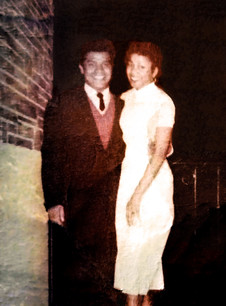
Jay Epae and Leona Laviscount
While the The Harlem Blackbirds were feted in public and received rave reviews wherever they went in Australia, there were a few instances of racism that were largely brushed under the carpet. Things were no better and, if anything, worse in New Zealand.
Trevor King was the tour manager for the New Zealand leg of the tour, which was his first international assignment. Trevor was scathing in his revelations to the Christchurch press: “NEGROES BARRED FROM HOTELS” he headlined his press release. “In Auckland and again in Wellington, we had some difficulty in finding accommodation for the negro members of the company. The company had been booked into two hotels in Auckland, but both proprietors returned the deposits when they realised that there were coloured artists in the cast. A Mt Eden woman placed two furnished houses free of charge at the disposal of the company. In Wellington most hotels were willing to accept the company, but one leading hotel refused with the excuse that they were booked up for race week.” The parochial King finished his statement: “But in Christchurch we have had no difficulty whatsoever”.
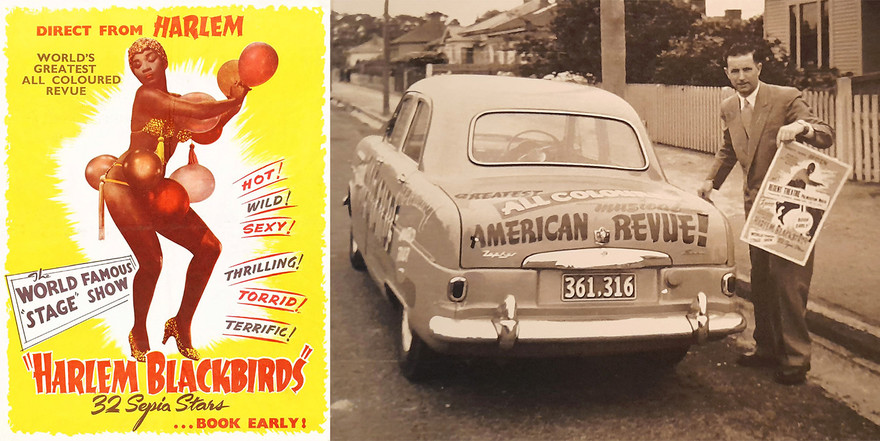
Christchurch promoter Trevor King heads out in his Zephyr to paste up the Harlem Blackbirds posters. - Alexander Turnbull Library, Wellington, Eph-D-CABOT-Variety-1956-01; Trevor King Collection
The cast and crew flew into Auckland on a chartered flight on 22 December for a 15-night season plus matinees at His Majesty’s Theatre, starting on Boxing Day. They then relocated to Wellington for a week at The Opera House – which the Epae family attended – before capping off a year on the road with seven nights in Christchurch starting on the 21st of January, 1956. The tour was a massive success in New Zealand. Just one ad in the NZ Herald in early December was enough to ensure all of the Auckland dates sold out. A review on 27 December reported: “A virile and dazzling company of performers entertained with speed, dynamic rhythm and uninhibited freshness. New Zealand has never seen anything like it.”
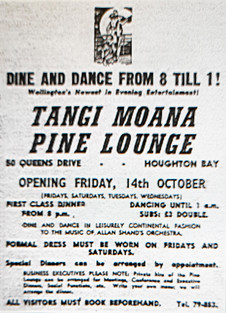
A newspaper advertisement for the opening of the Tangi Moana Pine Lounge, aka The Pines, on Wellington's south coast, 1955. - Grant Gillanders Collection
Tui Epae: “Jay, Leona and a few of the Blackbirds stayed with me in my little upstairs two-bedroom flat at 132 Willis Street, next door to the St George Hotel”. After the tour Leona and Jay stayed on in New Zealand and commuted between Manaia and Wellington for most of the year. Jay and Leona both managed to get regular work at the Tangi Moana Pine Lounge, which opened on Wellington’s South Coast on 14 October 1955. Within a few weeks of opening the venue was simply called The Pines.
Wes Epae recalls some fun times in Manaia: “We would all pile into the bus down to the local dance hall on a Saturday night, men on one side and woman on the other side, the flagon out the back and a ladies’ working bee in the supper room. Leona would turn up in her fancy gear and have the hall mesmerised and she would always do a few of her dance routines and have everybody gasping.”
To Jay, his wife Leona was his Princess, while Leona called him “her little Māori Elvis”
Jay and Leona were inseparable to the point that when Jay and the boys would go fishing on visits to Manaia, Leona who couldn’t swim would be placed on the rocks and the boys would only row out a short distance so that they never left each other’s sight. To Jay she was his Princess, while Leona called Jay “her little Māori Elvis”.
Although Leona loved New Zealand and its culture she soon became homesick for the bright lights of New York and at year’s end the couple relocated to New York. Leona – using her married surname Epae – immediately joined Cab Calloway’s 1957 Revue. It started on 22 December 1956, with an eight-week residency in Miami followed by 12 weeks in Las Vegas, returning to their home base in New York in late July, before a second three-month residency at year’s end in Miami. The revue was based on Calloway’s popular Cotton Club shows from the 1940s.
Leona became the poster girl for the revue when she appeared on the cover of the Las Vegas entertainment magazine, Fabulous. It was during this period that Orson Welles described her as having the best legs in the business, which Calloway took advantage of by utilising them on the back of his 1958 album, Cotton Club Revue, on the Gone label.
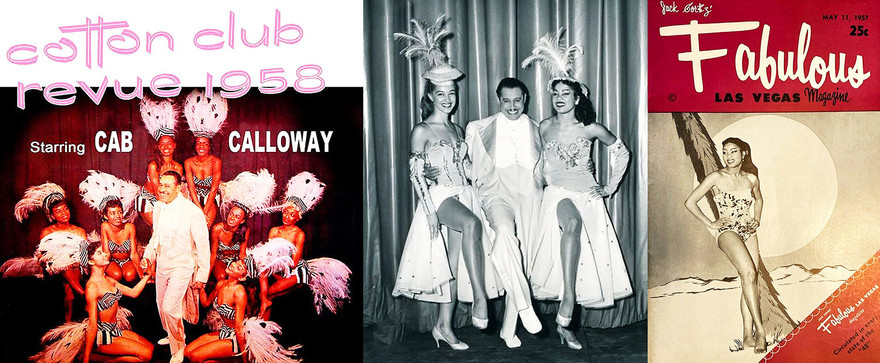
Leona Epae (neé Laviscount) with Cab Calloway and on the cover of Las Vegas entertainment magazine Fabulous, 1957
Jay and Leona set up home at West 84th Street on Manhattan, where Jay passed himself off as an Hawaiian and rode the wave of the popular kon-tiki culture which was at its peak across the United States and especially popular in New York. Jay found work at the Hawaiian Eye Restaurant, albeit as a kitchen hand, before a regular performing gig at the iconic Hawaiian-Kai restaurant on Broadway. Leona’s daughter Lyn recalls her mother saying that the kitchen was Jay’s happy place along with the stage.
With Leona’s contacts and Jay’s exposure at the Hawaiian-Kai, he was soon mixing in the right circles. By the end of the decade Leona had morphed into a jazz singer under the name “Lyn Cornell” (not to be confused with the blonde English pop singer of the same name, a former member of the Vernon Girls). As a jazz singer Leona performed at New York clubs Birdland and the Apollo and would often perform alongside the celebrated 1940s group The Inkspots. One of the Inkspots’ recent additions was ex-Orioles singer Gregg Carroll of ‘Crying In The Chapel’ fame. Carroll – who was looking to establish a solo career for himself – recorded ‘Going Back To Tennessee’, a song that Jay co-wrote with esteemed writer-producer-arranger-keyboardist Sampson Horton. It was released on the prestigious OKeh R&B label in May 1960.
Jay’s big break came a few months later during September 1960 when Mercury Records (US) decided to undertake a general artist expansion programme. Each of the A&R managers from their four regional branches were asked to sign appropriate artists in their respective areas. Clyde Otis was in charge of A&R for Mercury’s Eastern division and contributed to the nationwide search by signing Jay and R&B singer Bobby Hendricks, who was already an established recording artist as a singer of The Drifters (he was the lead vocal on their song ‘Drip Drop’).
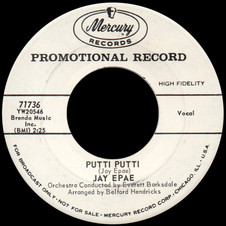
Promotional copy of Jay Epae's Putti Putti (Mercury, 1960)
Hawaii became a state of the US in August 1959 and possibly Otis had thoughts of promoting Jay to a new and untapped island market, while taking note that Jay was a budding songwriter. Otis was himself a successful songwriter and producer having written ‘Any Way You Want Me’, ‘Doncha Think It’s Time’, and ‘Ain’t That Lovin’ You Baby’ for Elvis Presley, as well as being instrumental in the careers of Mercury artists Brook Benton and Dinah Washington. At the time of signing Jay to Mercury, Otis was working on establishing Jackie DeShannon’s Liberty label recordings. Jay’s partnership with Otis would remain in place for the duration of his American career, which would see him working and writing with the cream of songwriters, producers, and arrangers on the East Coast of the US. In 1962 Jay signed with Otis’s newly formed booking and publishing companies.
For his debut single Jay chose to re work ‘Putti Putti’, a song that was a favourite in the Epae family and one that their father Tuni would sing to his children. ‘Putti Putti’ started life in mid-1938 as ‘I’m Gonna Lock My Heart (and Throw Away The Key)’ – a Top 10 hit for Billie Holiday. The song was re-written by Tuini Ngawai as ‘Putiputi Kaneihana E’ and can be heard on streaming platforms, sung by the New Zealand 28 (Māori) Battalion and recorded in 1942.
Jay gave the song a new lease of life with a set of saucy lyrics – on top of an already set of saucy lyrics – and a tempo change, before dedicating it to Leona. ‘Hawaiian Melody’ was the B-side and was written by Jay and esteemed songwriter/ arranger, Belford Hendricks, Clyde Otis’s right hand man and Nat King Cole’s producer/ arranger. Jay was a big fan of Cole so this would have been a special session for him. The single was released as Mercury 71736 on the 26 December 1960. Both sides of the single were enthusiastically reviewed in Billboard: “An upbeat rocker, Hawaiian style. The chanter has a touch of Belafonte in his voice and the side is sold effectively. Can get a lot of play in the Islands”. Meanwhile Cashbox gave it a “B” (Good) rating and wrote: “Colourful Hawaiian-styled beat with a lively combo chorus and electric Hawaiian guitar.”
‘Putti Putti’ was about to sink when it was thrown a life-saver from a Swedish pirate radio station
December has always been the least conducive month for record releases, especially for a new artist, and this should have been the end of the trail for ‘Putti Putti’. But just as the record was about to sink into the sea of forgotten new releases it was thrown a life-saver from an offshore Swedish pirate radio station.
Radio Nord began broadcasting on the 8 March 1961 from a ship anchored in the Baltic Sea, off the coast of Stockholm.
It was Radio Nord’s sound engineer Bengt Törnkrantz who discovered the disc in the station’s reject pile. He played it, liked what he heard, and on a whim added ‘Putti Putti’ to the playlist. It received its first airing on 3 May when presenter Gert Landin played the song; this received an immediate reaction from the station’s listeners. The pirates were quickly swamped with requests for this 2'25" slice of sunshine fun just as the northern summer was approaching.
‘Putti Putti’ stayed on the Swedish charts for 44 weeks; in Sweden alone it reached No.1 and sold 50,000 copies. In the process it became a song that is as much a part of the Swedish music consciousness as ‘She’s A Mod’, ‘Bliss’ or ‘Nature’ is to New Zealanders.
Jay's international career was hitting its stride, but he would find some of his most lasting success back home in Aotearoa.
--
Jay Epae’s epic career, 2: from 'Tumblin' Down' to Wellington